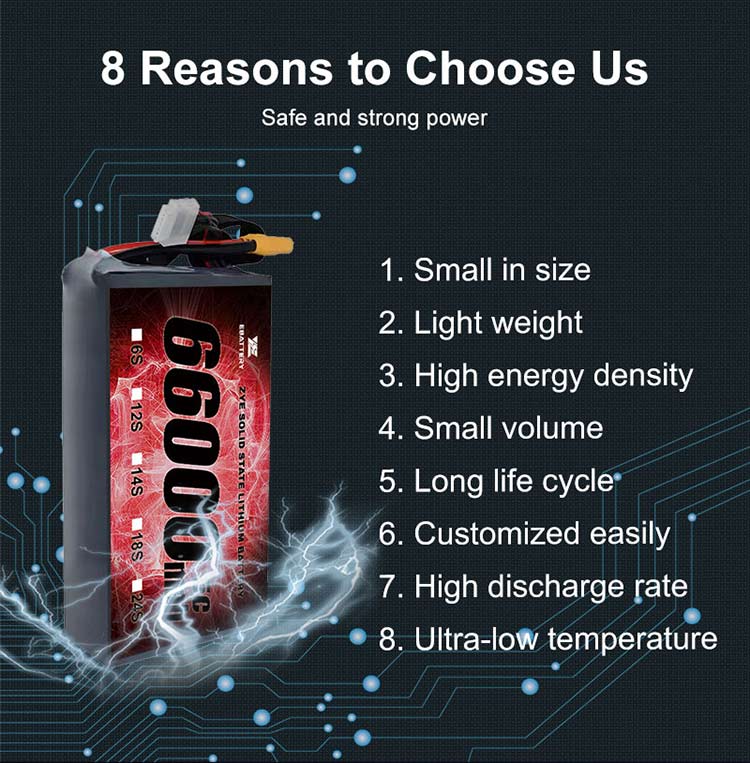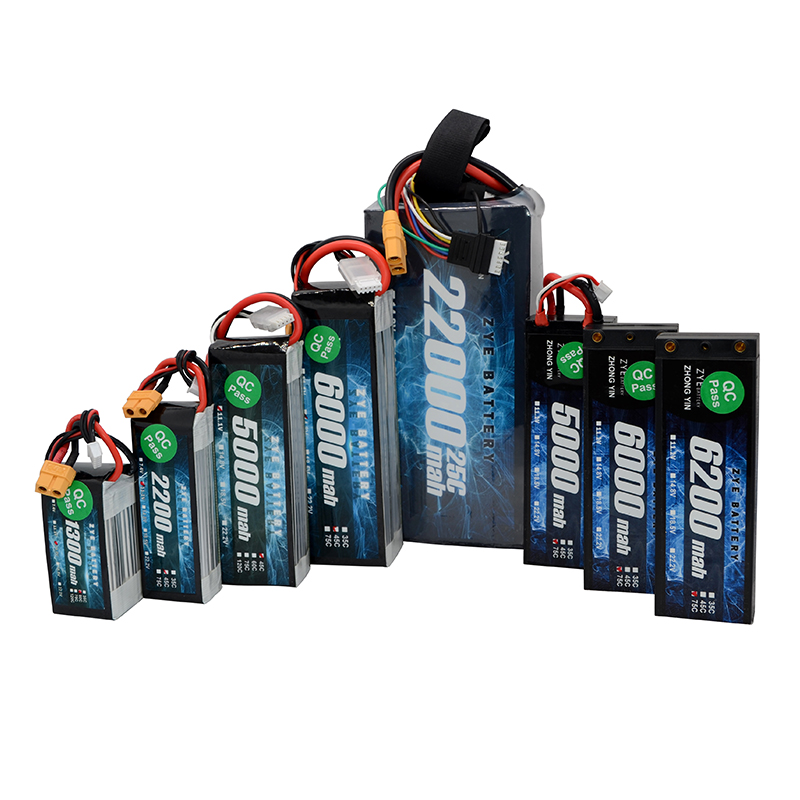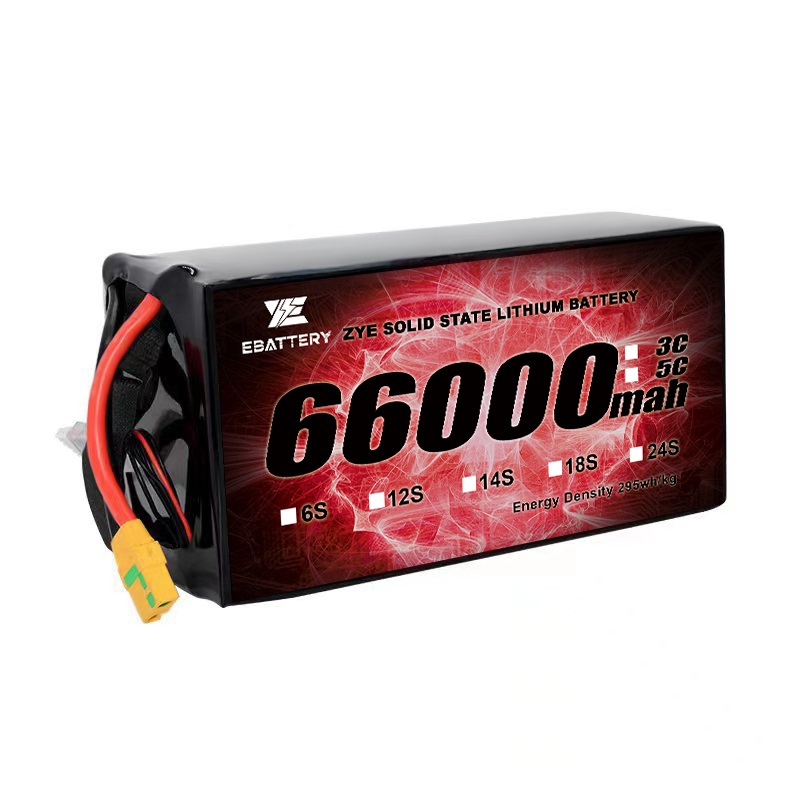How to calculate capacity in Lipo Battery Systems?
2025-09-22
When it comes to maximizing your drone's performance, the battery isn't just a power source—it's the heart of your operation. Whether you are using drones, electric vehicles, or other high-power applications, understanding how to accurately determine battery capacity can have a significant impact on the success of your project.

In this comprehensive guide, we will delve into the complexity of lithium battery capacity calculation, explore the key factors that affect performance, and provide you with the tools to make informed decisions.
At first glance, battery capacity seems simple: it's the number printed on the label. But what does it really mean, and how do you use that number to predict flight time and performance? Let's break it down.
Battery capacity is a measure of the charge a battery can store and, subsequently, deliver to a circuit. For drone LiPo batteries, this is typically indicated in two ways: Milliamp-Hours (mAh) and Watt-Hours (Wh)
mAh and Wh: Which Capacity Measurement is Most Important for Drone Batteries?
When measuring the capacity of lithium batteries, two units of measurement are commonly used: milliampere-hours (mAh) and watt-hours (Wh). Both provide valuable information about the battery's energy storage capacity, but they have different uses and are more relevant in specific contexts.
1. Milliampere-hours (mAh) is a measure of charge and indicates how much current a battery can provide over time. For example, a 5000mAh battery can theoretically provide 5000 milliamps (or 5 amps) for one hour before being depleted. This measurement is particularly useful when comparing batteries of the same voltage, as it is directly related to the amount of stored charge.
2. On the other hand, watt-hours (Wh) is a measure of energy. It takes into account both the current (in amps) and the voltage of the battery, providing a more comprehensive understanding of the total available energy.
To calculate Wh, simply multiply the battery voltage by its capacity (in ampere-hours (Ah)). For a 14S lithium battery with a nominal voltage of 51.8V, a 5000mAh (5Ah) capacity would convert to 259Wh (51.8V * 5Ah).
And to calculate the operating time of a lithium battery, several factors other than battery capacity need to be taken into account. To obtain an accurate estimate, we need to consider the battery's voltage, capacity, efficiency, and the power consumption of the connected load.
Runtime (hours) = (Battery Capacity (Ah) * Nominal Voltage * Efficiency) / Load Power (W)
It is worth noting that this calculation provides an estimate under ideal conditions. Actual performance may be affected by the following factors:
1. Temperature: Extreme temperatures can reduce battery efficiency and capacity.
2. Discharge rate: High discharge rates can cause voltage drops and reduce overall capacity.
3. Battery age and condition: Older batteries or those that have undergone many charge cycles may have reduced capacity.
4. Voltage cut-off: Most systems will shut down before the battery is completely drained to prevent over-discharge.
From Capacity to Flight Time: A Practical Estimation
While Wh tells you the total energy, estimating flight time requires understanding your drone's power draw. Here’s a simplified way to think about it:
1.Estimate Average Power Draw: This depends on your drone's weight, motor efficiency, and flying style. A common mid-range FPV or photography drone might draw an average of 150-250 watts. Check your drone's specifications for a better idea.
2.Use the Watt-Hour Calculation: From the example, the 3S 3000mAh battery has 33.3 Wh of energy.
3.Calculate Theoretical Flight Time:
Time (hours) = Energy (Wh) / Power Draw (W)
4.Let's assume an average power draw of 200W:
Time = 33.3 Wh / 200 W = 0.1665 hours
5.Convert to Minutes:
0.1665 hours × 60 minutes ≈ 10 minutes
A good rule of thumb is to only use 75-80% of the stated capacity to maximize battery life. So, a more realistic flight time for this setup would be 7-8 minutes.
The "C" Rating: Delivering the Capacity
You can't talk about capacity without mentioning the C-rate. The C-rate defines how quickly the battery can safely discharge its stored capacity.
Continuous Discharge Rate: A "30C" rating on a 3000mAh battery means it can continuously supply a current of:90A
If your drone's motors and electronics demand more current than the battery can supply, the battery will overheat, sag violently in voltage, and be permanently damaged.
Conclusion:
Understanding these interlocking concepts empowers you to make informed decisions—selecting the right battery for your aircraft, predicting flight times accurately, and, most importantly, operating safely and efficiently.
At ZYEbattery, we don't just sell batteries; we provide power solutions engineered for reliability and performance. Our technical specialists are always ready to help you calculate your exact power needs and ensure you get the most out of every flight.When it comes to maximizing your drone's performance, the battery isn't just a power source—it's the heart of your operation. Whether you are using drones, electric vehicles, or other high-power applications, understanding how to accurately determine battery capacity can have a significant impact on the success of your project.
In this comprehensive guide, we will delve into the complexity of lithium battery capacity calculation, explore the key factors that affect performance, and provide you with the tools to make informed decisions.
At first glance, battery capacity seems simple: it's the number printed on the label. But what does it really mean, and how do you use that number to predict flight time and performance? Let's break it down.
Battery capacity is a measure of the charge a battery can store and, subsequently, deliver to a circuit. For drone LiPo batteries, this is typically indicated in two ways: Milliamp-Hours (mAh) and Watt-Hours (Wh)
mAh and Wh: Which Capacity Measurement is Most Important for Drone Batteries?
When measuring the capacity of lithium batteries, two units of measurement are commonly used: milliampere-hours (mAh) and watt-hours (Wh). Both provide valuable information about the battery's energy storage capacity, but they have different uses and are more relevant in specific contexts.
1. Milliampere-hours (mAh) is a measure of charge and indicates how much current a battery can provide over time. For example, a 5000mAh battery can theoretically provide 5000 milliamps (or 5 amps) for one hour before being depleted. This measurement is particularly useful when comparing batteries of the same voltage, as it is directly related to the amount of stored charge.
2. On the other hand, watt-hours (Wh) is a measure of energy. It takes into account both the current (in amps) and the voltage of the battery, providing a more comprehensive understanding of the total available energy.
To calculate Wh, simply multiply the battery voltage by its capacity (in ampere-hours (Ah)). For a 14S lithium battery with a nominal voltage of 51.8V, a 5000mAh (5Ah) capacity would convert to 259Wh (51.8V * 5Ah).
And to calculate the operating time of a lithium battery, several factors other than battery capacity need to be taken into account. To obtain an accurate estimate, we need to consider the battery's voltage, capacity, efficiency, and the power consumption of the connected load.
Runtime (hours) = (Battery Capacity (Ah) * Nominal Voltage * Efficiency) / Load Power (W)
It is worth noting that this calculation provides an estimate under ideal conditions. Actual performance may be affected by the following factors:
1. Temperature: Extreme temperatures can reduce battery efficiency and capacity.
2. Discharge rate: High discharge rates can cause voltage drops and reduce overall capacity.
3. Battery age and condition: Older batteries or those that have undergone many charge cycles may have reduced capacity.
4. Voltage cut-off: Most systems will shut down before the battery is completely drained to prevent over-discharge.
From Capacity to Flight Time: A Practical Estimation
While Wh tells you the total energy, estimating flight time requires understanding your drone's power draw. Here’s a simplified way to think about it:
1.Estimate Average Power Draw: This depends on your drone's weight, motor efficiency, and flying style. A common mid-range FPV or photography drone might draw an average of 150-250 watts. Check your drone's specifications for a better idea.
2.Use the Watt-Hour Calculation: From the example, the 3S 3000mAh battery has 33.3 Wh of energy.
3.Calculate Theoretical Flight Time:
Time (hours) = Energy (Wh) / Power Draw (W)
4.Let's assume an average power draw of 200W:
Time = 33.3 Wh / 200 W = 0.1665 hours
5.Convert to Minutes:
0.1665 hours × 60 minutes ≈ 10 minutes
A good rule of thumb is to only use 75-80% of the stated capacity to maximize battery life. So, a more realistic flight time for this setup would be 7-8 minutes.
The "C" Rating: Delivering the Capacity
You can't talk about capacity without mentioning the C-rate. The C-rate defines how quickly the battery can safely discharge its stored capacity.
Continuous Discharge Rate: A "30C" rating on a 3000mAh battery means it can continuously supply a current of:90A
If your drone's motors and electronics demand more current than the battery can supply, the battery will overheat, sag violently in voltage, and be permanently damaged.
Conclusion:
Understanding these interlocking concepts empowers you to make informed decisions—selecting the right battery for your aircraft, predicting flight times accurately, and, most importantly, operating safely and efficiently.
At ZYEbattery, we don't just sell batteries; we provide power solutions engineered for reliability and performance. Our technical specialists are always ready to help you calculate your exact power needs and ensure you get the most out of every flight.
























































